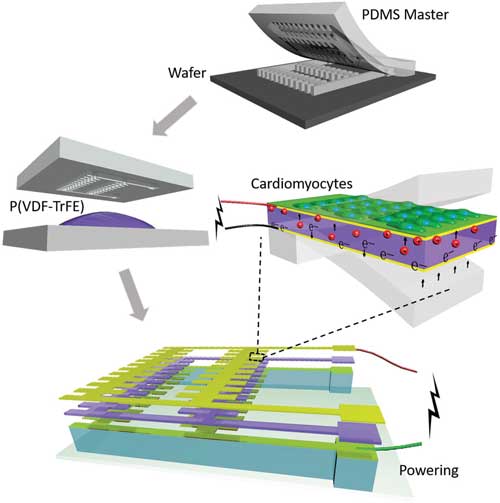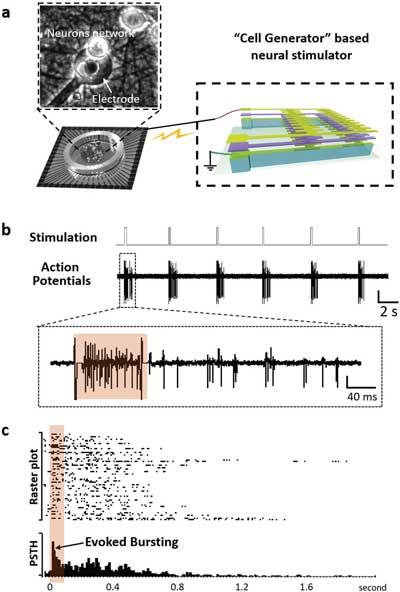| Posted: Mar 31, 2017 | |
Cell generator: Harvesting energy from cells for micro biomedical applications |
|
| (Nanowerk Spotlight) Recently, great progress has been made in the development of bio-hybrid devices with enhanced biological, mechanical and electrical designs. Several muscular tissue based actuators have been described and devices with cultured heart cells have also been reported to produce electrical outputs. | |
| Now a novel bio-hybrid system, the “Cell Generator”, was demonstrated by Dr. Shi Peng’s Lab at the City University of Hong Kong (Advanced Functional Materials, "Cell Generator: A Self-Sustaining Biohybrid System Based on Energy Harvesting from Engineered Cardiac Microtissues"). | |
 |
|
| Schematics and the fabrication procedures of the “Cell Generator”. Piezoelectric P(VDF-TrFE) cantilevers were micropatterned by injection-molding from a PDMS master. The contraction of engineered cardiac microtissues deflected the cantilevers and induced piezoelectric potential, which was interfaced via gold electrodes for specific power applications. (Reprinted with permission by Wiley-VCH Verlag) (click on image to enlarge) | |
| The researchers integrated piezoelectric material with 3D-engineered living constructs for energy harvesting and electricity generation. | |
| The device was essentially based on an array of piezoelectric cantilevers, which was deformed by the spontaneous contraction of cardiac muscle cells, thus transducing mechanical vibration into electrical energy. The whole cantilever design was particularly customized to match the tiny force generated by cardiac micro-tissues, so that the device was sufficiently sensitive to pick up microscale disturbances by the contraction-relaxation of multicellular cardiac tissues. | |
| The major advance of this work is the development of a practically functional device that significantly boosts the piezoelectric output from cells by using a novel material along with an expandable miniature instrumentation design. | |
| From a practical perspective, the researchers demonstrated a feasible strategy to converge small piezoelectric signals to functional outputs. | |
| In practice, the cell-based device was very suitable for the low-power-consuming applications on the micro-scale biomedical robotic device. | |
| As the authors demonstrated in this study, the “Cell Generator” was used to stimulate cultured neuronal network. With further development, this neural stimulating device could to be integrated into implantable neural stimulation devices, such as cochlear implants. | |
 |
|
| Self-powered neural stimulator based on the “Cell Generator”. a) Schematics showing the stimulation of neuronal cells on a multielectrode array by using a “Cell Generator” to provide electrical stimulus signals. b) Recording of neuronal action potentials in response to 700 mV voltage simulation from a “Cell Generator”. The boxed region is enlarged to show the spiking activity during one stimulation period. c) A raster plot and corresponding peristimulus time histogram (PSTH) showing the temporal correlation between the stimulus signals (from the “Cell Generator”) and the evoked spiking activity in neuronal cells. (Reprinted with permission by Wiley-VCH Verlag) (click on image to enlarge) | |
| Also, micro-machines based this design could potentially be used as a power-free and self-sustainable robot to perform diagnostic or therapeutic tasks in human body. | |
| The integration of active elements from biological systems, such as cells and tissues, with mechanical or electronic interfaces presents unique opportunities for creating bio-hybrid machines that are adapted to respond to complex stimuli for a range of engineering applications. | |
| The scientists hope that the “Cell Generator” technology can provide an innovative perspective of exploiting live biological components for the development of self-sustaining cellular machines and bio-hybrid systems. | |
| Provided by the City University of Hong Kong | |
|
Become a Spotlight guest author! Join our large and growing group of guest contributors. Have you just published a scientific paper or have other exciting developments to share with the nanotechnology community? Here is how to publish on nanowerk.com. |
|
